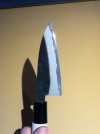DocJD
Basic Member
- Joined
- Jan 29, 2016
- Messages
- 12,186
I wasn't being critical of the carbon steels . But I see large numbers of old tools at auctions and on peoples' farms and there is rarely any doubt that they are not a bit stainless . Visually obvious , no licking required . I'm not speaking of neglected or abused tools caked with scaly rust . Just ones with long service and average care , no longer shiny and polished . That's what I associate tool steel looking like from what I saw growing up around old equipment , well used and often outdoors ; in dirt , manure , plant sap etc . Patina , thick and rich with history ."Lot of maintenance" is flat out wrong. Keeping your blade clean (sweeping it with your handky or on your jeans, whatever...), washing it with hot water and soap every two or three months, adding a drop of oil on the pivot (and/or a rub on the blade)... is just what everybody has done since centuries. And those carbon blades are still fully functional (folders from the 19th century, swords from the 15th, and on..). Stainless steels are actually nice but they are not the greatest event since the last giant meteorite.


